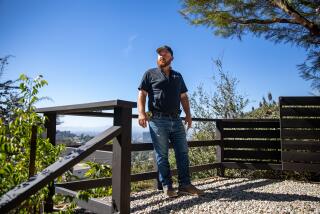Tales From the Crypt Good for Business
- Share via
BOJNICE, Slovakia — What do you do when slime oozes from the tomb of a 19th-Century count in the castle crypt and a guard dog returns as a barking ghost?
First “secure the health of all your workers,” says Jan Papco, director of Bojnice Castle in central Slovakia. Then count your blessings.
The number of visitors to this 1,000-year-old castle has steadily increased to about 300,000 in 1992 since word of a malodorous liquid seeping from the tomb of Count Jan Palffy, Bojnice’s last owner, leaked beyond its walls two years ago.
“At first it all looked like bad publicity and we worried over what to do about it,” said Papco, an art historian. “But gradually the reaction went from a problem to an asset.”
Bojnice Castle, set on a hill between the Vtacnik and Small Tatra mountain ranges of central Slovakia, has become a magnet for followers of the occult, psychics and curious tourists.
Purported ghost sightings on the castle grounds are so common they are hard to count, said Papco, who talks of apparitions with the glibness of an advertising executive and the authority of a professor.
He hopes to attract foreign businessmen to the castle for conferences and has added a six-room bridal suite for honeymoons with a difference. Japanese visitors love the place, he said.
An official of the European Bank for Reconstruction and Development recently praised Papco’s marketing of the castle as an example of how to promote tourism in Slovakia, which became independent Jan. 1 with the division of Czechoslovakia.
Count Jan Palffy, a Hungarian aristocrat who died in 1908, was the last of his family to live in the castle. With him the 300-year tradition died.
When a mysterious fluid began oozing from Palffy’s tomb beneath the castle chapel, several staff quit and others refused to set foot in the crypt.
“When we found the fluid, we thought about sudden deaths of those who open tombs, like in Egypt,” Papco said.
He brought in a small army of experts to study the fluid, contacted the Austrian grandson of the tomb’s builder and had the inside of the sarcophagus searched with microscopic cameras.
The experts concluded that the ooze was no more than the liquid remains of Count Palffy and embalming fluids.
But the welter of publicity was enough to add to the folklore surrounding the castle and Palffy himself, a reclusive bachelor whose main passion lay in art.
Palffy’s will stipulated that his heirs should keep his art collection at Bojnice. But after a series of lawsuits the count’s beloved collection of tapestries, sculpture, paintings and furniture was divided and sold.
Most important to the collection are 12 panels by the 14th-Century Florentine painter Nardo di Cione, which now sit in the National Gallery in Prague, capital of the Czech Republic.
Palffy’s lost panels are part of a controversy over the division of national treasures between the Czechs and Slovaks that has lingered since their country split in two.
“Any Slovak can tell you that this flow from Palffy’s tomb won’t stop until these treasures are returned,” Papco said.
Adding to the lure of Bojnice’s battle for lost art and its leaking tomb are its legendary ghosts.
Guards at the castle say ghost sightings typically peak around midnight. Miroslav Potociar, 21, a night watchman, says that now and then he hears a woman’s tortured scream from the basement, which fades as he approaches.
He says he has also spotted the apparition of a guard dog.
Then there’s the gilded angel’s head, which supposedly has been witnessed several times spinning on a ceiling in the castle’s Golden Room.
“Everybody’s frightened, but as time goes by you get used to it,” Potociar said.
Such tales may be good for business. But not all locals are impressed.
“There are definitely ghosts in that castle,” said 20-year-old Jana Wohlander, pointing up the hill to the castle’s turrets from a cafe in Bojnice. “I would never spend a night up there.”
More to Read
Sign up for Essential California
The most important California stories and recommendations in your inbox every morning.
You may occasionally receive promotional content from the Los Angeles Times.













